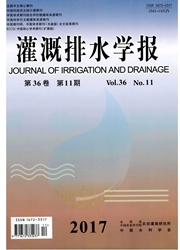

 中文摘要:
中文摘要:
大田试验条件下设置常规水稻(T11)、覆膜旱作水稻(T12)、覆草旱作水稻(T13)和裸地旱作水稻(T14)4个处理,研究旱作水稻的节水效率及水分利用效率。水稻本田期T11用水总量545.40 mm,显著高于各旱作处理水稻,以此为参照,T12、T13和T14节水效率分别为35.1%、22.8%和21.2%。以裸地旱作处理T14为参照,T12节水率17.7%,而T13无明显节水效果。旱作水稻的节水效果主要发生在水稻移栽后前2个月,之后无明显节水效果。各处理以籽粒产量/耗水量为基础计算的水分利用效率(WUE),T12、T13、T14和T11处理分别为1.47、1.31、1.21和1.05 g/kg,以干物质量/耗水量为基础计算的WUE各处理之间的趋势与以籽粒产量/耗水量计算的WUE基本一致。
 英文摘要:
英文摘要:
Field experiments with four treatments that were normal paddy rice (T12), aerobic rice with plastic film mulching (T12), aerobic rice with straw mulching (T13) and aerobic rice without mulching (T14) were set up to explore the water-saving and water use efficiency of aerobic rice in South China. The amount of water consumed by Tll was 545.40 mm, which was significantly higher than that of aerobic rice treatments. Comparing with Tll the water saving efficiency (WSE) of T12, T13 and T14 was 35. 1%, 22.8% and 21.2% respectively. Comparing with T14 the WSE of T12 was 17.7%, and water consumption of T13 was almost the same as T14. The effective water saving period of aerobic cultivations was the first two months after transplanting and then there was no significant water saving effect. The water use efficiency (WUE) calculated with grain yield divided by total water consumption of aerobic cultivations were significantly higher than that of normal paddy rice. The WUE of T12, T13, T14 and Tll was 1.47, 1.31, 1.21 and 1.05 g/kg respectively. The trend of WUE of each treatment calculated with biomass divided by total water consumption was same as WUE calculated with grain yield divided by total water consumption.
 同期刊论文项目
同期刊论文项目
 同项目期刊论文
同项目期刊论文
 期刊信息
期刊信息
